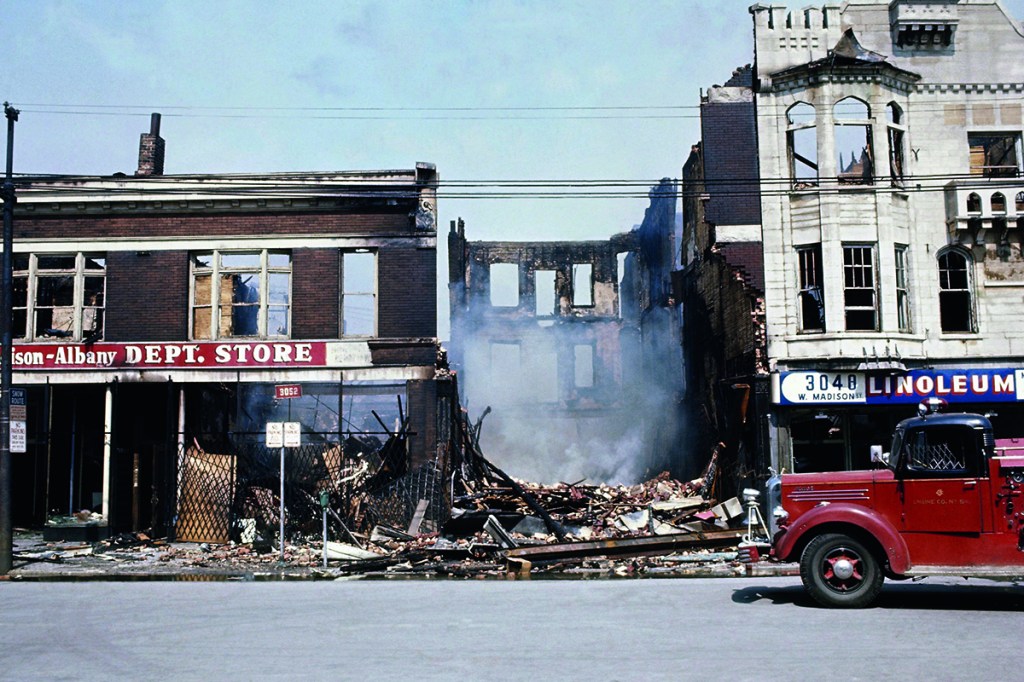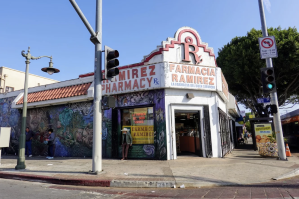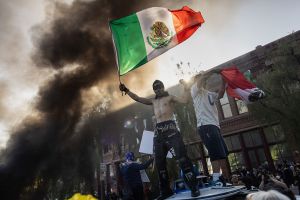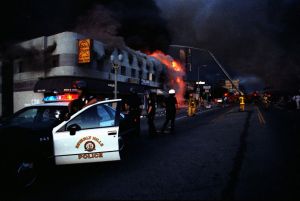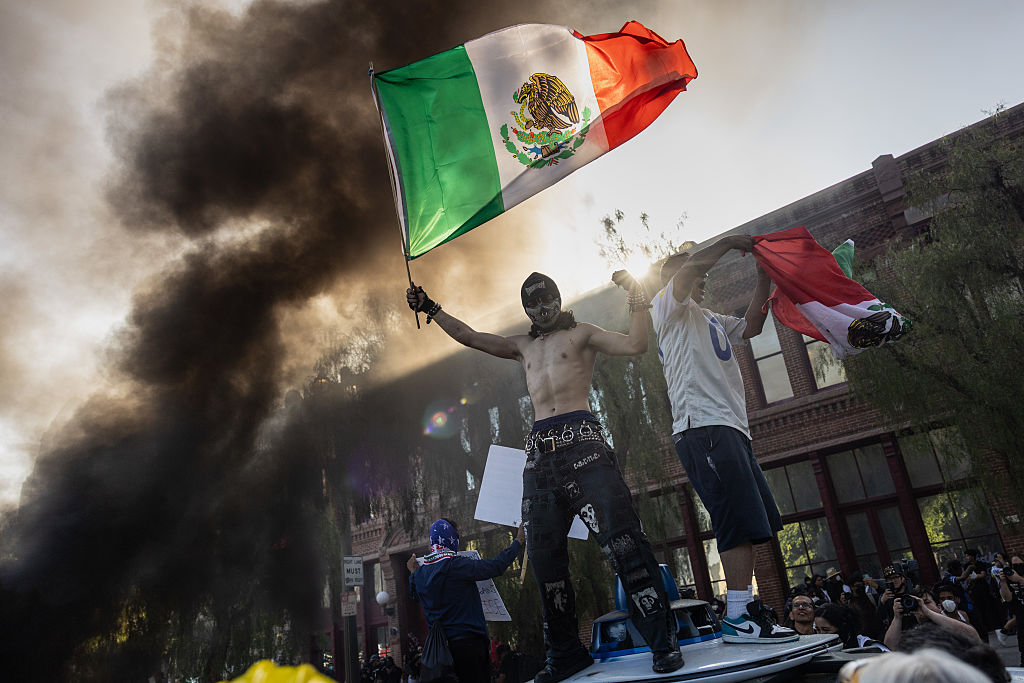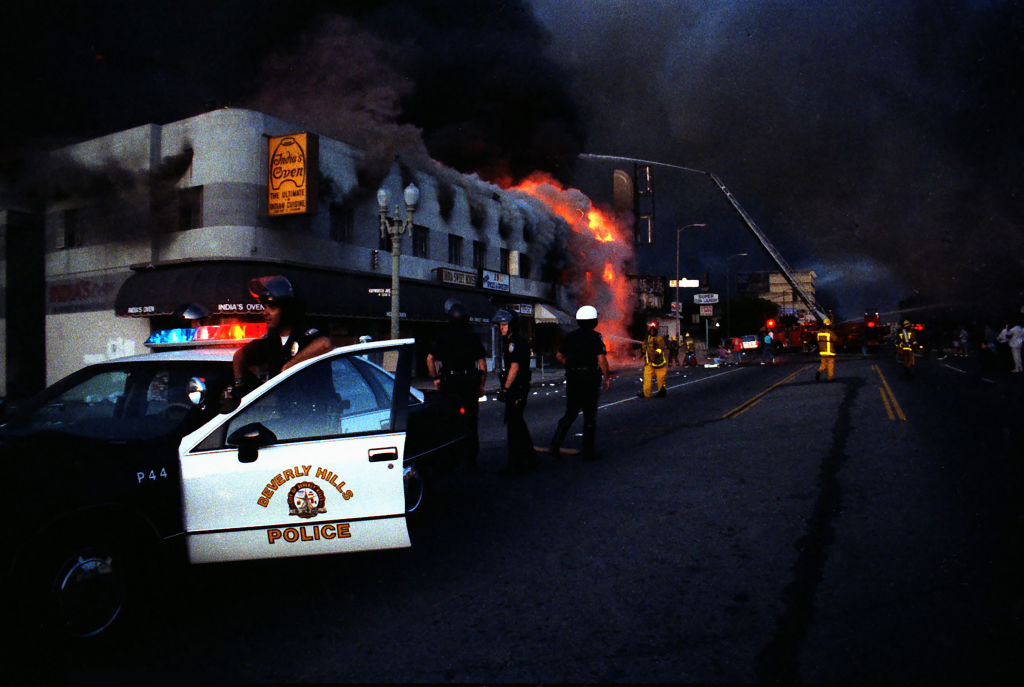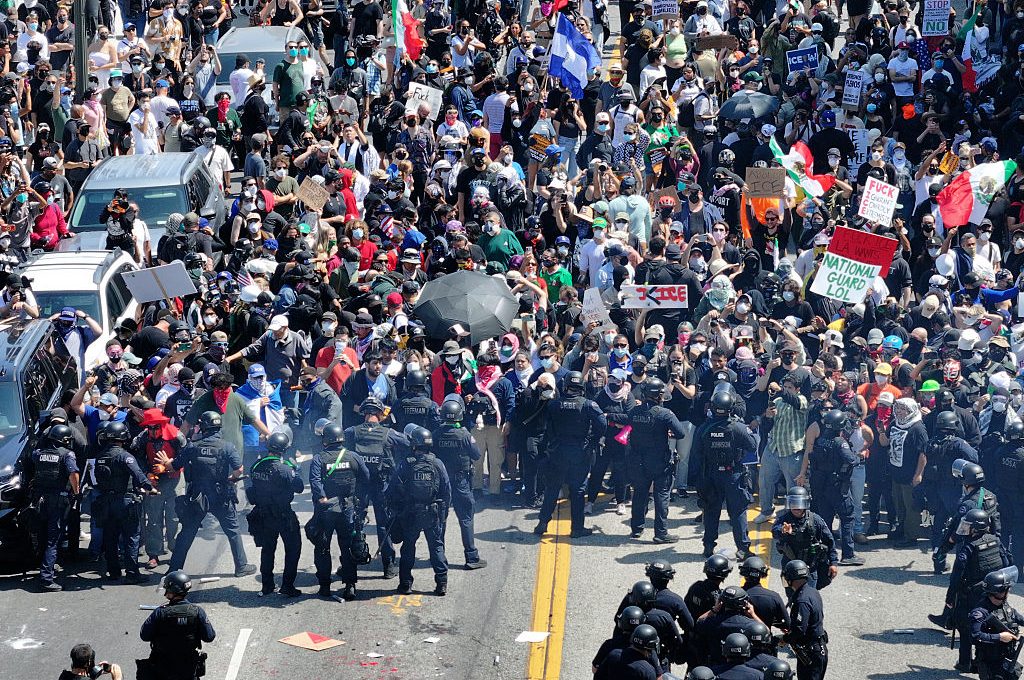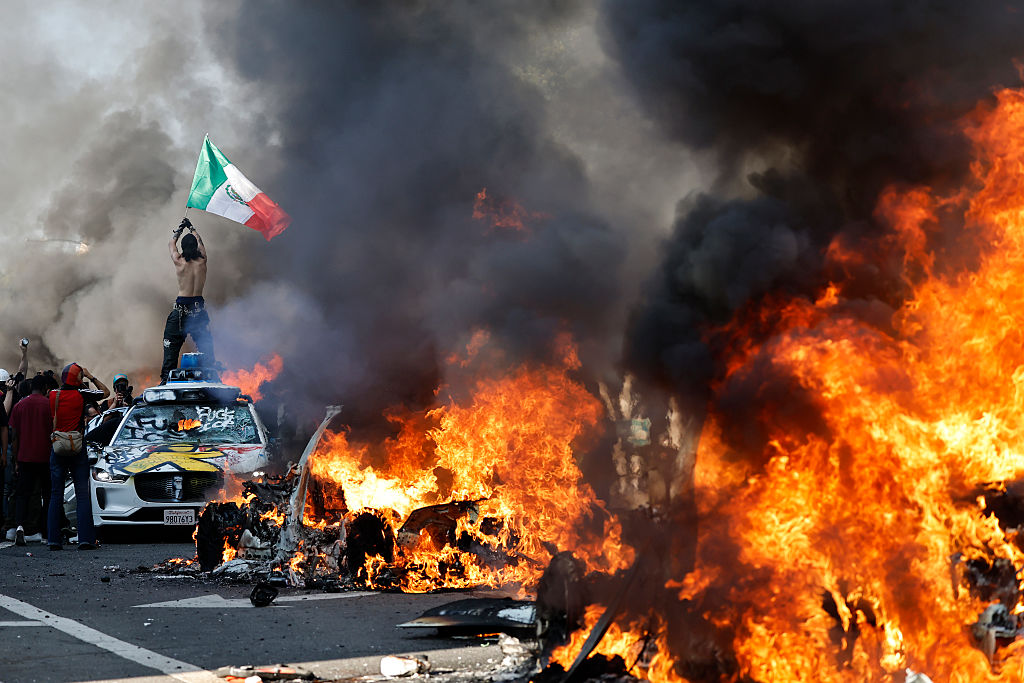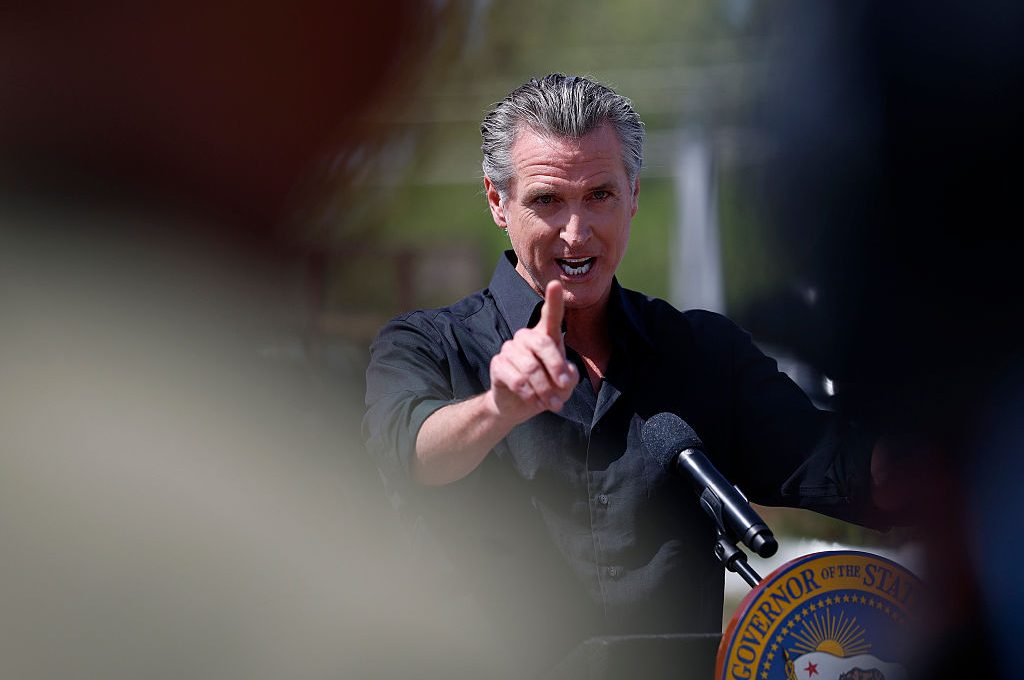The causes of violent rioting and looting are complicated and often include real, unaddressed grievances. One thing is clear, though: looting has few winners and many losers. The losers in the long run are often those breaking the windows and making off with the bling.
Many of us are trying to get a handle on the unrest we’ve witnessed in 2020. History doesn’t repeat itself, and, pace Mark Twain, it may not even rhyme, but sometimes a little context helps, if only to suggest possibilities. The considerable scholarly literature on the ‘race riots’ of the 1960s is mostly sympathetic to the rioters. It excuses or at least countenances violence because its authors share what they perceive to be the rioters’ goals: racial equality, social justice and the like. I offer another, less common point of view. My family was directly impacted by the violent rioting in Chicago after Martin Luther King’s death. Our story is a cautionary tale about the ‘work’ that violence, arson and looting can do: permanent economic and social damage.
***
I grew up in Chicago in the 1950s and 1960s. My family lived on the second floor of a two-flat — my mother’s parents lived on the first floor — near Ashland and Diversey in a working-class neighborhood on the North Side. Until the end of 1965 my father was a milk-truck driver for the Bowman Dairy Company, hauling out of a garage in Bronzeville. In January 1966 Bowman got bought out by a larger rival, Dean Foods. Although my father was a loyal union man (he was for a time a shop steward for IBT Local #753), he got bumped in terms of seniority. This made him mad and motivated him to look around for something else.
As it happened, an Italian guy who lived in a three-flat across the street from us was looking to sell a bar on the West Side on the northeast corner of Lake and Pulaski. His asking price for the lease and fixtures (he didn’t own the building) wasn’t a lot, but it was more than my father could handle alone, so he asked his younger brother, a cop, if he wanted in. His brother was ready for a change too, and together they ponied up. In spring 1966 they bought the neighbor’s bar, keeping the name that he had given it: the Miami Lounge.
Lake and Pulaski was right under the ‘L’ (elevated trains) in the West Garfield Park district of Chi; Pulaski formed the easternmost edge of what African Americans in the area were later to call ‘K Town’. West Garfield Park at the time was transitioning from majority-white to majority-black. It was growing poorer, but there was still a lot of manufacturing in the area and a considerable number of whites were still living on the side streets north of Lake Street. East Garfield Park and North Lawndale were by then almost entirely black, but Austin District, to the west of West Garfield Park, was still overwhelmingly white.
The bar was of the type known at the time as a ‘barrel house’: a shot-and-a-beer joint. No frills, just a long, 40-stool bar, a pool table and a couple of tables and chairs. The clientele was almost entirely male, and the bar was open from 7 a.m. until 2 a.m. Monday through Friday, 7 a.m. to 3 a.m. on Saturdays, and noon until 2 a.m. on Sundays. Lots of workers in one or another factory, foundry or tool-and-die on the West Side wanted a snort before work and a few boilermakers afterwards, and the location under a busy L station was very good. The customer base was mostly white, but African Americans were often present too, and African Americans accounted for most of the sales of ‘package goods’ (takeouts), mainly cheap whiskey or rye, pints or half pints of fortified wine such as Richards Wild Irish Rose, or bigger bottles of Thunderbird. It was a fun place in a rough-and-ready, old-school working-class kind of way.
Business went well at the Miami Lounge for the first few months. My father and my uncle had spent a good bit of time at the Miami doing ‘due diligence’, as it were. They had sent their friends there at various times during the day for a drink or two and to check out the place. Everyone agreed: what’s not to like? What tavern owner in Chi wouldn’t want a place in a blue-collar industrial zone right below an L station? It seemed a no-brainer.
As it turned out, it wasn’t. In July 1966 a violent riot occurred on the West Side: a sign of things to come. Riots and violent incidents were increasingly common in Chi at the time; Puerto Ricans had rioted on Division Street in June. The West Side riot began further south and east, around Roosevelt Road and Throop, but it rippled throughout the West Side, including to West Garfield Park. The July 1966 riot was a bad one, much worse than the shorter outburst in West Garfield Park in August 1965. The 1966 riot lasted three or four days before the cops, aided by 1,200 National Guardsmen, put it down. Numerous stores on the West Side were set afire and looted. People were shot (including firemen and policemen) and two people killed. Hundreds of arrests were made, and for a time service on the Lake Street L was stopped because of sniper fire.
Although the Miami Lounge was located in the riot zone, it escaped with only a couple of broken windows. Lake Street near Pulaski was still mostly industrial. The rioters in West Garfield Park focused their attention a bit further south, closer to the commercial center of the area at Madison and Pulaski, which had been the center of the 1965 riot. Other parts of the West Side, particularly along Roosevelt Road and further east on Lake Street, got hit much worse.
My father and uncle had dodged a bullet, so to speak, and the West Side remained relatively calm for the better part of the next two years. That said, the neighborhood was getting rougher all the time, and my father and his brother did have to deal with incidents. Some thieves broke through the back door one night after closing and stole some cash and a good bit of booze. In the course of the robbery, they severely beat the bar dog with baseball bats, injuring her so badly that a vet had to put her down the next day.
Another night a guy broke into my father’s car, parked in a vacant lot behind the bar, and hid on the floor behind the front seat, covering himself with a drop cloth. Fortunately for my father, a patron who was leaving the bar saw the break-in and circled back to tell my father and uncle what he’d seen. By closing time, my father and uncle had devised a plan. They sneaked up on the perp, dragged him out of the car, disarmed him (he had a knife) and, using a couple of blackjacks that they kept near the cash register, performed what was known in Chicago at the time as a ‘street rhapsody’ on his head. The tune left the guy moaning on the ground in the alley.
Some problems, then, but for the most part things were still going reasonably well. That is, until all hell broke loose in the aftermath of the shooting of Martin Luther King. The Reverend King was shot and killed in Memphis on the night of Thursday April 4, 1968. Civil unrest began almost immediately all over the country.
By the morning of April 5 Chicago was gearing up for major trouble. The Chi authorities now had considerable experience with rioters and had developed some preemptive measures to slow things down a bit. One of these measures — a telltale sign that bad stuff was expected — involved the Department of Sanitation.
On the morning of April 5 its trucks went to high-risk areas to pick up the big iron-mesh garbage bins — about the size of standard 55-gallon drums — that were ubiquitous on street corners in Chicago at the time. City officials had learned the hard lesson that these bins were the instruments of choice for discriminating looters interested in smashing display windows as quickly and efficiently as possible. A smart move, but, alas, one of little moment as a two-day orgy of violent rioting, window-smashing, arson and looting began that afternoon on both the West Side and the South Side, before spreading to several other parts of the city.
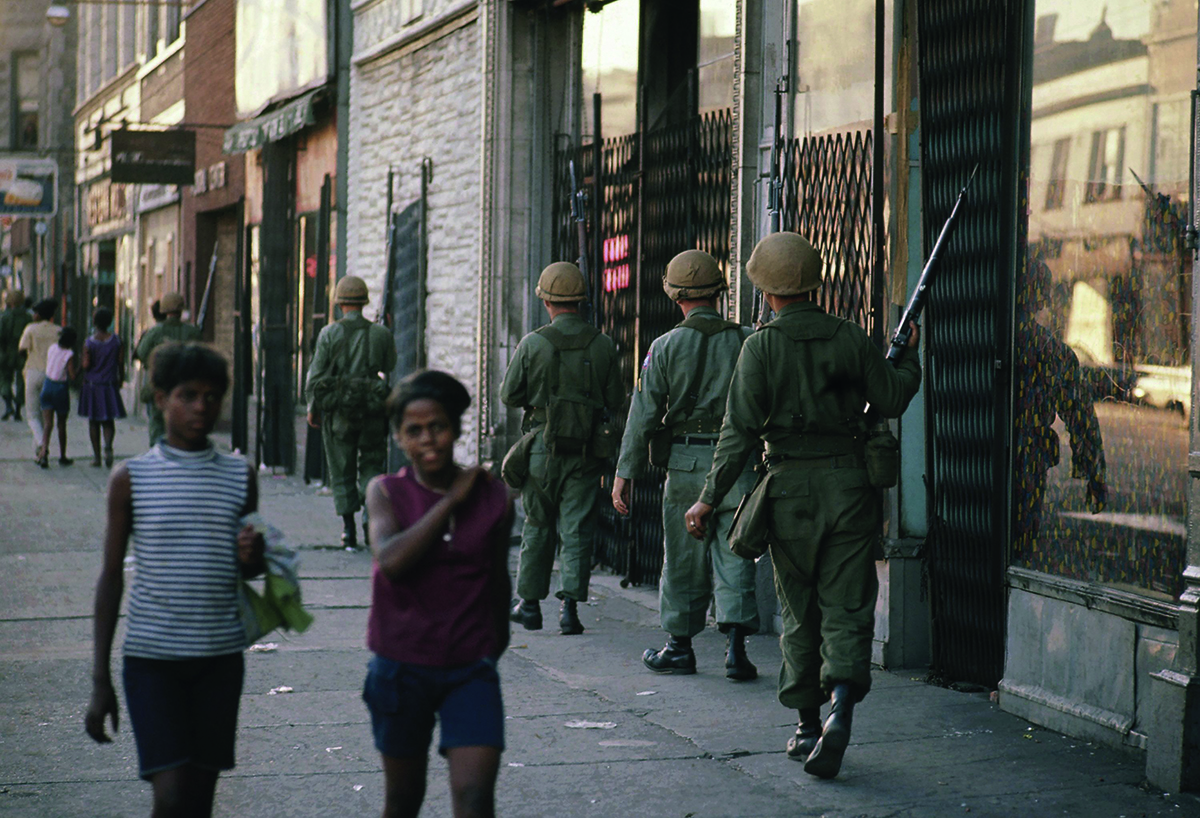
With July 1966 well in mind, my father and uncle were ready. They had moved their vehicles from the vacant lot behind the Miami earlier that morning, reparking them several blocks north on a block that was still white, and spent the day preparing for the bad things to come. Neither my father nor his brother had much formal education — my father left school after eighth grade and his brother even earlier — but they were both tough, street-smart war veterans who took no shit from no one, no matter what. They had a plan for vandals, and in hindsight it seems to have consisted of three basic parts.
First, they counted on the fact that because the place was viewed as cop-friendly, neighborhood rioters might think twice. The Miami wasn’t what was known as a cop bar per se, but my uncle was an ex-cop and my cousin was a young cop in the nearby Austin District. Cops were around a lot, whether in uniform or plain clothes, whether on duty and just saying hello or off-duty to put down a few. It wouldn’t be hard, even for frenzied rioters, to suss out that the Miami Lounge might have a greater cop presence (or at least a quicker response to mayhem) than another venue down the street.
Secondly they had guns. Not the most imposing arsenal, but one sufficient to render rioters and certainly looters cautious. My uncle retained a pistol and a revolver from his days as a cop. He kept them both at the bar, and people knew it. Both handguns were kept in good working order, which was more than could be said for the other two weapons in the arsenal. There was an ancient shotgun my father had inherited from his great-grandfather, who had acquired it after immigrating to the US in the early 1890s and working as a ‘gandy dancer’, laying railroad tracks out West for a few years, before returning to Greece. And there was a Japanese military rifle my father had brought back after serving in the Pacific theater during World War Two.
If some of the weapons appear a bit dicey, so did some of the forces wielding them. My uncle knew how to shoot, but my father didn’t. The two people backing them up had issues too. One was a neighborhood guy, a regular at the Miami, nicknamed ‘Bobko’: B-O-B for Bob, he told me, and K-O for knockout. A nice enough guy and plenty tough, but a heavy drinker. The other was an older man, tall with long, matted reddish hair and a long, red-gray beard. Not surprisingly — the Miami wasn’t known for cleverness, much less irony — he was known as ‘Red’. Today most people would refer to him as a street person, if not a homeless bum. If Red were still around he would deny the latter appellation: he was neither homeless (he lived in an abandoned boxcar in a little-used freight yard north of Lake Street) nor a bum, but in his own words a hobo. A hobo, Red said, worked sometimes, while a bum never worked. And Red, who also drank a lot, worked some at the Miami, running errands, doing some portering, helping to stock up.
Anyway, this was the basic group that defended the Miami during the 1968 riots. Two guys with guns showing behind the big plate-glass window on Pulaski, two guys with guns showing behind the big plate-glass window on Lake. During lulls, these folks were sometimes joined by others, including cops at times, who needed a break, some coffee, maybe something stronger.
The third part of the plan — ingenious in retrospect — probably did more than anything else to keep roving arsonists and looters at bay. This one was my father’s doing. When he and his brother had bought the Miami, he had commissioned a sign painter, a friend of his, to stencil in, underneath the Miami Lounge lettering on both the Lake Street and Pulaski Road sides of the building, the words ‘The Coclanis System’. The mob was still big in Chicago at the time, and it had always had a strong position on the West Side. After all, Al Capone’s home base had been in Cicero, just to the south and west of West Garfield Park and North Lawndale. Even in the late Sixties, Chicagoans feared the mafia, and shady-looking guys were in and out of bars all the time, usually because the outfit controlled most of the pool tables, juke boxes and the bar-towel and linen services.
My father’s given name in Greek was Evangelos, but everyone called him Angelo, which, at least in Chicago at the time, was a name commonly associated with Italians. Many people in Chicago — certainly on the West Side — would have taken Angelo Coclanis for Italian rather than Greek, and my father figured that the ‘Coclanis System’ lettering on the Miami would send out a signal that the bar was a mafia concern and to steer clear. That the entire ‘system’ consisted of the lease to the bar and my uncle’s pickup truck was immaterial.
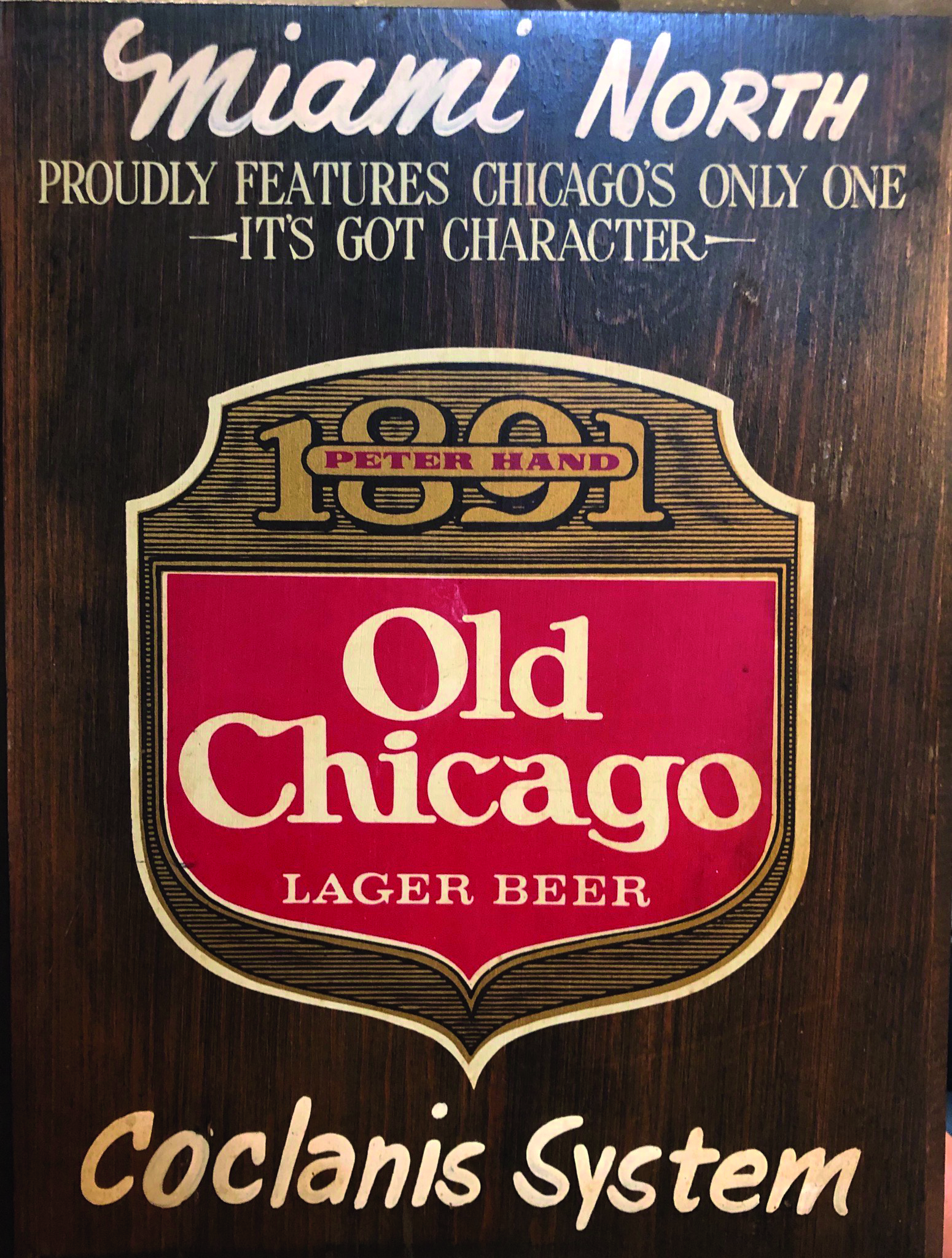
That was the defensive strategy in a nutshell, and somehow it worked. The West Side, especially the commercial strip on West Madison from about Damen to Pulaski and the businesses on Roosevelt Road, turned into a war zone on the afternoon and night of Friday, April 5, to the sound of gunfire, explosions from Molotov cocktails, the shattering of windows, the screech of police and fire sirens, the flash of ambulance lights and the smoke and acrid smell from the many buildings set aflame.
By early morning on Saturday April 6, most of the store windows on the West Side were gone, and the contents of the store interiors looted. Machine shops, tool-and-dies and warehouses up and down Lake Street were vandalized and sometimes badly damaged. Cars were overturned and burning, and the streets were flowing with water, mud, blood, broken glass and trash.
The rioting was too much for the police to handle alone, and on April 5, Mayor Richard J. Daley had asked for reinforcements from outside. On April 6 almost 7,000 Illinois National Guardsmen took to the streets in aid of the 10,000-plus Chicago police force, and President Lyndon Johnson ordered 5,000 soldiers from the 1st Armored and 5th Infantry divisions into Chicago. That same day Daley (supposedly) issued his famous ‘shoot to kill’ order to police, though it is often forgotten that he distinguished between arsonists and Molotov cocktail throwers on the one hand, and generic looters on the other. Cops, according to Hizzoner, should ‘shoot to kill’ the former, but ‘shoot to maim or cripple’ the latter.
The increased manpower and firepower did the trick, and by Saturday night the worst of the violence, arson and looting was over. On Sunday there were scattered incidents, but the riot had clearly wound down. At least nine people had been killed — a strikingly low toll when compared with routine levels of violence in inner-city areas in Chicago and many other cities today — and 1,200 injured. By then, though, much of the West Side was unrecognizable.
***
During the riot, the phone at the Miami somehow still worked. On the morning of Sunday, April 7, my father called home and asked me to bring some fresh clothes to him and my uncle that afternoon — if the tenuous calm still held. During the 1966 rioting, my father and uncle had been holed up in the bar for two or three days, living on Slim Jims, Beer Nuts and Jays Potato Chips, and they had no idea how long they’d be stuck there this time.
The Miami had no air-conditioning, they were closed up inside and the whole neighborhood was hot and sweaty from all the fires. I was 15 at the time, had no driver’s license, but had been taking the bus to the bar for a couple of years to help stock up and to porter. We lived about six miles away — three miles north and three miles east, and two bus rides would get me there: Diversey west to Pulaski and, under normal circumstances, Pulaski south to Lake.
Buses were still running normally on Diversey — no rioting on its route — but the Pulaski buses weren’t going any further south than Division Street or maybe Augusta, leaving me about a mile from the Miami. I’d have to walk the rest of the way.
My father told me that before coming down I should go to the right top drawer of the chest in my parents’ bedroom, where he kept an envelope with cash, and take out 20 or 30 singles. He told me to empty my wallet of everything, then to fill it with the singles. If I got jumped or jack-rolled by a group of thieves while walking south on Pulaski, they might spare me a kick to the head or a shiv under my ribs if they extracted a fat wallet from my pocket.
I did as he instructed, got the clean clothes down to the Miami that afternoon without incident, stuck around for a couple hours, then retraced my route and got back home before dark. Fifty-odd years later I still remember walking north on Pulaski, watching military helicopters in the sky, coming and going from some location further west (which I later learned was the grounds of Austin High School). The peace held, though, and by Monday the rioting had ended. By then it was too late for a lot of people for a lot of reasons.
The Miami, being part of the Coclanis System, got off easy: a few broken windows, a damaged door, but no arson or looting. Got off easy in the short run, that is to say. The week after the rioting, the bar’s insurer told my father and uncle that it would not be renewing the Miami’s ‘dram shop’ liability insurance or its general coverage. A bar needs both. A drunk falls off of a bar stool and cracks open his skull: lawsuit. A hophead leaves a bar ‘stiffer than a bull’s prick’, as they used to say in Chi in the waning days of the city’s stockyards, jumps into his car and crashes, killing himself and others: lawsuit. You obviously need general coverage too. After two major riots in two years, it wasn’t going to be easy to get either any more on Lake and Pulaski.
After the fires burned themselves out and the rubble was cleared my father and my uncle did manage to reopen, but business was never the same. Many commercial businesses on the West Side had been gutted, and numerous factories, scrap-metal dealers, warehouses, junkyards and lumber yards in the area had been badly damaged. Many of the foundries, machine shops and tool-and-dies never returned, heading not to Mexico but mainly to safer sites in nearby industrial suburbs like Elk Grove Village. Some stores reopened eventually, but many others did not, leaving large swaths of East Garfield Park and North Lawndale and smaller sections of West Garfield Park in ruins: crumbling walls, twisted metal, brickpiles, scattered debris and vacant lots.
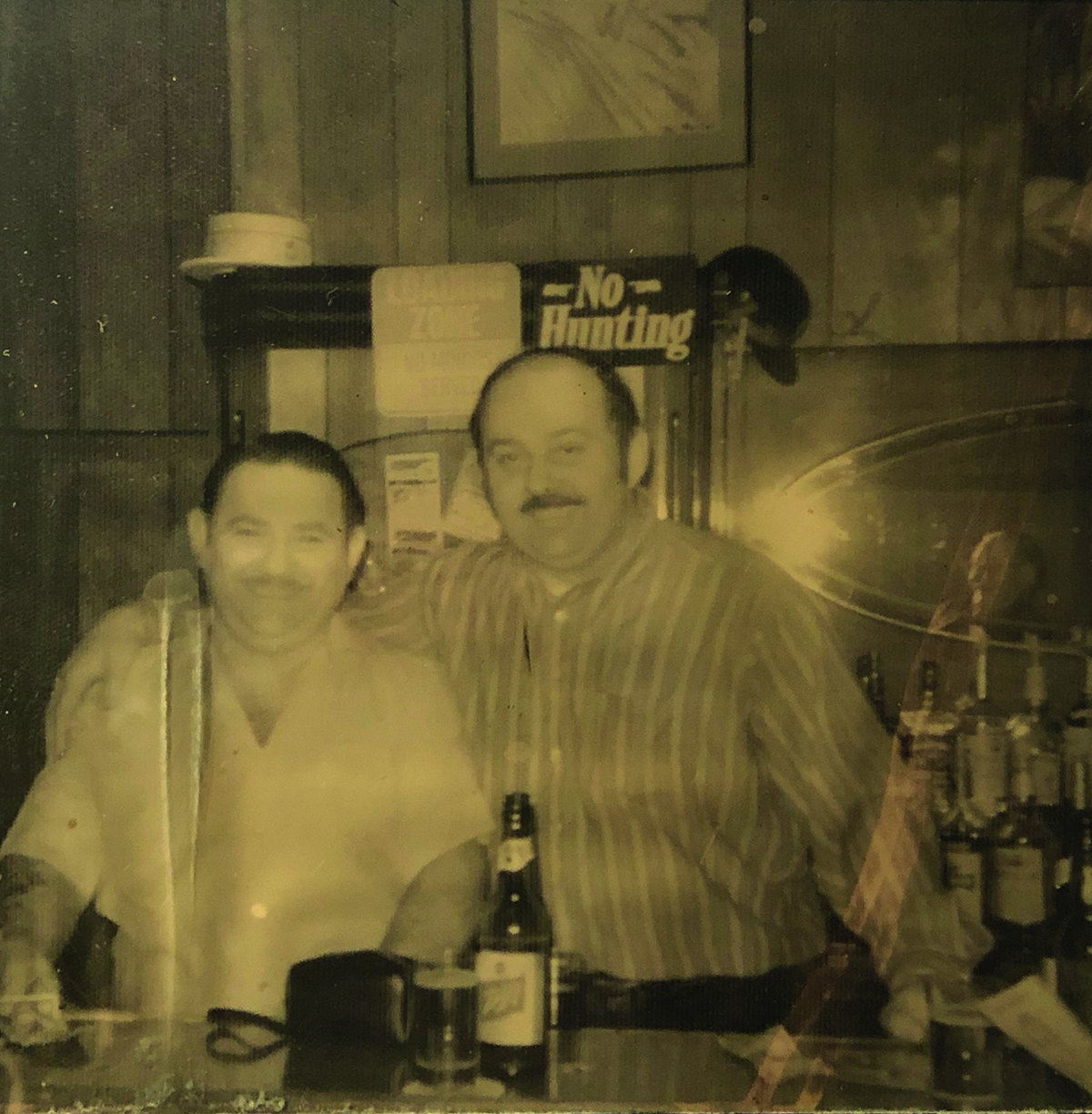
Although my father and my uncle ultimately found other insurers, they had to pay through the nose for pretty rudimentary coverage, and in mid-1970 they sold the Miami and quit the West Side. Later that year they opened another bar on the North Side called (not too surprisingly) the Miami North. My father and his brother liked to locate near L stations, and their new place, at 4623 N. Western (on the corner of Western Avenue and Eastwood) was located about a half-block south of the big Western Avenue station on what was then called the Ravenswood Line.
The bar was another working-class barrel house, the clientele this time almost entirely white. My father and his brother had a decent run at the Miami North, but business was never as good as it had been at the Miami on the West Side. They ran the Miami North for 10 years before closing in 1980 with a whimper not a bang, after a fight with the German landlord over the building’s plumbing.
My father was 54 and my uncle 51, so they had to find other ways to make ends meet. My uncle got a job driving school buses on split-shifts for the Skokie School District and held it for almost 20 years until he retired. My father and mother, tired of the city, moved to southwestern Wisconsin, where my father held a variety of jobs for the next 16 years until he too retired: night watchman at a gravel quarry, assembly at a clothes-hanger factory, night janitor at a machine shop that customized trucks, scrubbing and polishing floors from 10 p.m. to 7 a.m. at Walmart store #802 in Monroe (the first Walmart in Wisconsin).
My uncle and my father both made out after closing first the Miami Lounge and then the Miami North, but in many ways their work lives and life satisfaction went pretty much downhill after the first weekend of April in 1968. The same can be said of West Garfield Park. To be sure, the area was already heading south by the mid-Sixties, getting increasingly poorer and blacker, riddled with crime, and businesses, particularly manufacturing plants, were quitting the area at an alarming rate. The two riots proved the coup de grâce.
The entire West Garfield Park/East Garfield Park/North Lawndale region became, and has remained, one of the grimmest and most forlorn landscapes of urban desolation in the country, a violent, job-poor area looked on, even in Chi, with pity and despair. The commercial footprint came to consist mainly of cheapo retail, convenience stores, fast food, pawnshops (the area’s key financial intermediary along with payday lenders) and liquor stores, mostly paying what urban planners and real-estate people call ‘wig-store rents’. West Garfield Park’s descent didn’t start with the 1966 and 1968 riots, but neither helped by intensifying white flight, manufacturing flight and, as a result, tax flight, all creating the conditions for painful and protracted urban blight.
***
In 2009 the business journalist Suzy Welch had a bestseller with 10-10-10. Welch laid out some useful ideas about the importance of perspective in decision-making. In her view, decisions or actions often look different over time. Before making a decision or performing an act, it is useful to think a bit about the likely results at varying intervals: in 10 minutes, 10 months and 10 years. Unfortunately, looters weren’t her target audience.
Sad numbers: 10 minutes, 10 months, 10 years — or, in the case of West Garfield Park, East Garfield Park and North Lawndale, 50 years. Some looter may have gotten himself a pair of shades last spring, but now his baby sister won’t be getting any infant formula because the Arab convenience store is gone. Another got some kicks, but his brother won’t be getting any amoxicillin for that ear infection and his mother her insulin because the Walgreens was looted and burned down.
‘Capital goes where it is welcome and stays where it is well treated,’ said Walter Wriston, the legendary chair of Citicorp, channeling or at least echoing Thomas Babington Macaulay. Capital, alas, is not being treated very well in areas plagued this year by violent rioting, arson and looting. These areas are already paying the price. They will likely continue to do so for a long time to come, notwithstanding the analysis of knuckle-headed leftists such as Vicky Osterweil, the daughter of an MIT professor, who recently wrote that ‘stealing goods and destroying property are direct, pragmatic strategies of wealth redistribution and improving life for the working class’.
Peter A. Coclanis is Albert R. Newsome Distinguished Professor of History at UNC-Chapel Hill and director of its Global Research Institute. This article was originally published in The Spectator’s December 2020 US edition.



